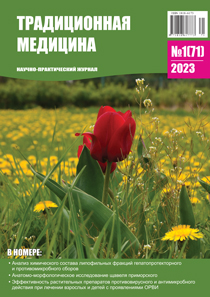Anatomical and morphological study of golden dock (Rumex maritimus L.)
DOI:
https://doi.org/10.54296/18186173_2023_1_13Keywords:
diagnostic features, external features, microscopic features, buckwheat family, PolygonaceaeAbstract
The aim of the research was to conduct a morphological and anatomical study of the aerial and underground parts of golden dock (Rumex maritimus L.).
Materials and methods. The aerial and underground parts of golden dock were collected in July 2017, August 2020. To study the morphological characteristics of the plant, a stereoscopic microscope “Micromed MS-1” was used. Micropreparations were examined under a “Mikmed-1” microscope. The images of the micropreparations were recorded using a Celestron digital microscope imager and a digital photo camera. The photos were edited in a free image editor GIMP 2.8.
Results. Morphological characteristics of Rumex maritimus are supplemented with a description of the ochreas: the ochreas are filmy, non-shiny, with papillary outgrowths clearly visible at 40? magnification; deciduous from large first-order stems. As the significant anatomical features of the golden dock’s aerial part the following can be listed: the presence of long bristle teeth along the edges of the inner tepals in fruits, two on each side of the tepal; irregular papillary thickenings along the edge of the leaf and its underside, along the edges of outer tepals, on the surface of the ochrea, on the ribs of the stem; outgrowths on the inner tepals, two on each side of the tepal; presence of glandular trichomes: four-celled with brown content on the surface of the leaf and inner tepals and two-celled in the stem and ochrea epidermis; longitudinal folding of stem epidermal cells.
Conclusion. The established diagnostic features of the aerial part of the plant can serve as proof of authenticity of the plant raw materials. The results of the study will be used in the developing of a pharmacopoeia monograph “Golden dock herb (Rumicis maritime herba)”.
References
Сосудистые растения советского Дальнего Востока. Т. 4 / под ред. А.Е. Кожевникова. – Л.: Наука, 1989. – 380 с.
Bioactive compounds and health benefits of edible Rumex species – A review / A.P. Mishra, M. Sharifi-Rad, M.A. Shariati [et al.] // Cell. Mol. Biol. – 2018. – Vol. 64, № 8. – P. 27–34. http://dx.doi.org/10.14715/cmb/2018.64.8.5
Two new phytoconstituents from Rumex maritimus / S.T. Abdullah, H. Hamid, M.S. Alam [et al.] // Indian J. Chem. – 2008. – Vol. 47, № 4. – P.619–622.
Uddin, K. Taxonomy and Traditional Medicine Practices of Polygonaceae (Smartweed) Family at Rajshahi, Bangladesh / K. Uddin, A.H.M. Rahman, A.K.M. Islam // Int. J. Adv. Res. – 2014. – № 2. – P.459–469.
Rouf, A.S.S. Evaluation of antidiarrhoeal activity Rumex maritimus root / A.S.S. Rouf, M.S. Islam, M.T. Rahman // J. Ethnopharmacol. – 2003. – Vol.84, №2–3. – P.307–310. https://doi.org/10.1016/S0378-8741(02)00326-4
Antioxidant, Antimicrobial and Antidiarrhoeal Activity of Methanolic Extract of Rumex maritimus L. (Polygonacea) / M.S. Hossain, M. Rashid, M. Rahman, S. Sadhu // J. Appl. Pharm. Sci. – 2015. – № 5. – P.56–60. 10.7324/JAPS.2015.510.S10
Islam, M.S. Evaluation of neuropharmacological effects of Rumex maritimus Linn.(Polygonaceae) root extracts / M.S. Islam, M.T. Rahman, A.S.S. Rouf // Pharmazie. – 2003. – Vol. 58, № 10. – P.738–741.
Арктическая флора СССР / под ред. А.И. Толмачева. – Ленинград : Наука, 1971. – Вып. 6. – 247 с.
Флора Сибири / под ред. Л.И. Малышева. – Новосибирск: Наука, Сиб. отд., 1988. – Т.5 / под ред. И. М. Красноборова, Л. И. Малышева. – 312 с.
Zhenyue W., Ying W., Yanzhi W. Studies on the Microscopical Structures of Eight Species Chinese Medicine from Rumex Root // Bull. Chin. Tradit. Herbal Drugs. – 1999. – Vol.30, №11. – P.855–858.
Общая фармакопейная статья ОФС.1.5.1.0002.15 «Травы». – ГФ XIV. – М., 2018.
Общая фармакопейная статья ОФС.1.5.1.0006.15 «Корни, корневища, луковицы, клубни, клубнелуковицы». – ГФ XIV. – М., 2018.
Общая фармакопейная статья ОФС.1.5.3.0003.15 «Техника микроскопического и микрохимического исследования лекарственного растительного сырья и лекарственных растительных препаратов». – ГФ XIV. – М., 2018.
Micromorphological investigation of foliar anatomy of Fagopyrum Mill. and Rumex L. of Polygonaceae / G. Yasmin, M.A. Khan, N. Shaheen, M.Q. Hayat // Pak. J. Bot. – 2010. – Vol.42, №1. – P.47–57.
Федосеева, Л.М. Анатомическое изучение щавеля кислого травы, произрастающего на территории Алтайского края / Л.М. Федосеева, Г.Р. Кутателадзе // Вестник ВГУ, Серия: Химия. Биология. Фармация. – 2018. – №3. – С.218–224.
Keshavarzi, M. Comparative anatomical and micromorphological study of some Rumex species (Polygonaceae) / M. Keshavarzi, F. Ebrahimi, S. Mosaferi // Acta Biol. Szeged. – 2018. – Vol.62, №1. – P.45–52. https://doi.org/10.14232/abs.2018.1.45–52
Taxonomic implications of Pollen morphology of seven species of Rumex L., from Pakistan / G. Yasmin, M.A. Khan, N. Shaheen [et al.] // Pak. J. Bot. – 2010. – Vol. 42, № 3. – P. 1435-1442.
Paul, P. Pollen morphology of selected Indian species from subfamily Polygonoidae (Polygonaceae) / P. Paul, M. Chowdhury // Biologia. – 2020. – №75. – P.1083–1095. https://doi.org/10.2478/s11756-020-00449-3
A comparative study of achene morphology in Korean Polygonaceae / M.J. Kong, J.H. Song, B.C. An [et al.] // Bangl. J. Plant Taxon. – 2018. – Vol. 25, № 2. – P.135–148. https://doi.org/10.3329/bjpt.v25i2.39536
Fruit morphology of the genus Rumex L. (Polygonaceae) in Iran / S. Shahla, A.A. Maassoumi, S.M. Hamdi [et al.] // J. Bio. & Env. Sci. – 2014. – Vol.5, №1. – P.655–663.с
Downloads
Published
How to Cite
Issue
Section
License
Reproduction of any materials without the written permission of the publisher is prohibited.
The responsibility for the accuracy of the information contained in articles and advertisements are the authors and advertisers.






